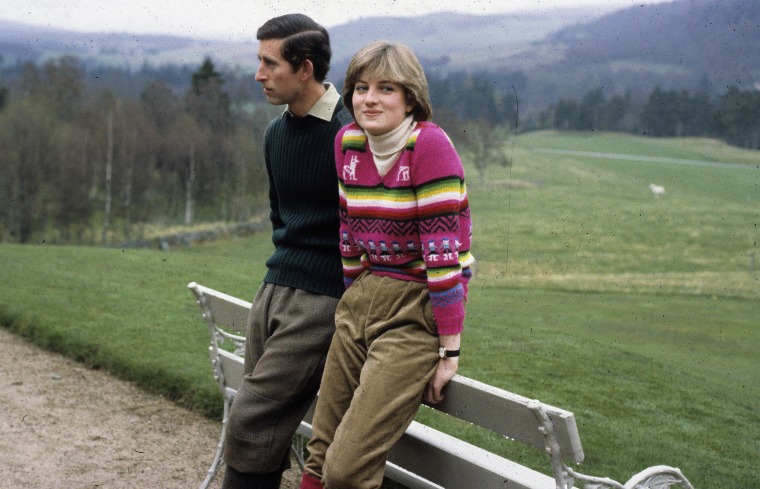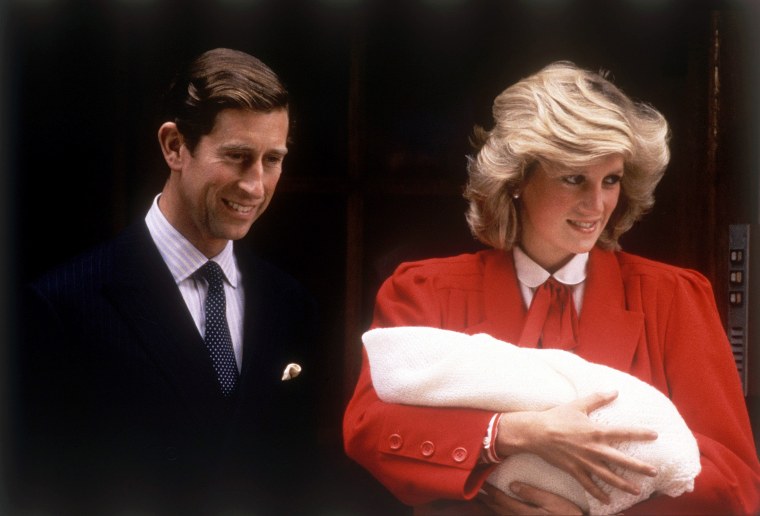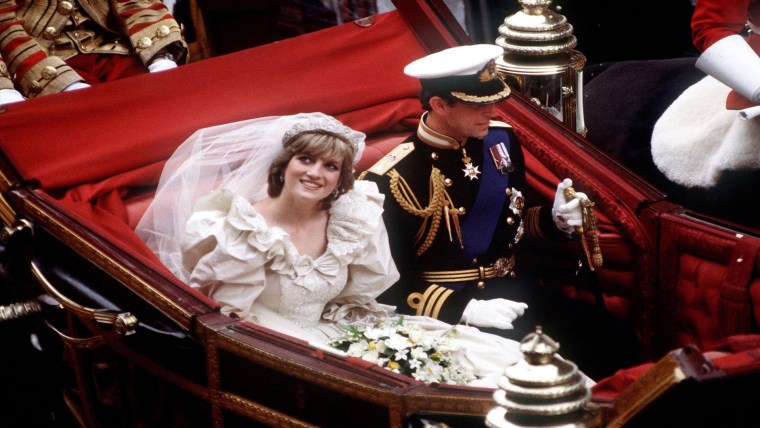
It was an event that captivated the public and renewed the notion of a fairy tale-worthy royal romance.
On July 29, 1981, Britain’s then-heir to the throne, Charles, Prince of Wales (now King Charles III), wed Lady Diana Spencer at London’s St. Paul’s Cathedral as an estimated 750 million people, per the BBC, around the world watched the pomp and circumstance play out on their televisions. Spectators dubbed it the “wedding of the century.”

But there were no such raves about the rocky marriage that followed it. Diana died in 1997, one year after being formally divorced. She left behind two sons.
Now, decades after Charles and Diana’s nuptials and divorce, their marriage is yet again the focus of public fascination.
This time, it’s thanks to the ’90s-set Season Five of “The Crown,” which shows a dramatized version of what happened in palaces and beyond (and it’s hardly the first movie, TV show or book to do so).
“The Crown” previously highlighted chapters in their relationship, like their engagement and age difference; their dance during their their 1983 Australia tour; and the close call avalanche during a skiing trip to Klosters in 1988, which killed one of Charles’ close friends. Season Five will depict even more highly publicized events, sparking backlash.
Here’s a look back at how King Charles III and Princess Diana’s relationship began and why it ended, informed by biographies and books both Charles and Diana contributed to.
November 1977: Charles meets Diana
Diana was just 16 years old when Prince Charles, nearly 13 years her senior, first visited her family’s West Northamptonshire estate, Althorp House, in November of 1977. He was there to take part in a grouse hunt at the invitation of Diana’s older sister, Lady Sarah Spencer, who’d briefly been linked to the eligible prince herself.
Years later, during Charles and Diana’s 1981 engagement interview, the couple reminisced about their first meeting, in which he noted that she made a memorable first impression.
“I remember thinking what a very jolly and amusing and attractive 16-year-old she was,” he said. “I mean great fun, bouncy and full of life and everything.”
November 1978: The prince’s birthday bash
One year later, Charles and Diana crossed paths again, this time at Buckingham Palace for his 30th birthday celebration, which Diana received an invitation to attend, as did her sister, Sarah.
In Andrew Morton’s “Diana: Her True Story, In Her Own Words,” Diana — who had a major hand in the creation of the book, recording her memories on audio tapes that Morton received, the author confirmed — recalled her sister asking, “Why is Diana coming as well?” The royal-to-be responded, “Well, I don’t know, but I’d like to come.”
The book said Diana had a “very nice time” at the party and found the company “fascinating,” adding, “I wasn’t at all intimidated by the surroundings. I thought: amazing place.”
July 1980: A royal romance begins
 Prince Charles, Prince of Wales and Lady Diana Spencer, at the estate at Craigowen Lodge in Balmoral, Scotland.Anwar Hussein / WireImage
Prince Charles, Prince of Wales and Lady Diana Spencer, at the estate at Craigowen Lodge in Balmoral, Scotland.Anwar Hussein / WireImage
In July of 1980, Diana, now a 19-year-old woman, came face-to-face with Charles once more. This time, Diana — in Morton’s book — said the Prince of Wales made a bold display of his affections.
Per Morton’s book, a mutual friend, Philip de Pass, invited Diana to spend some time at his family’s home in Sussex, telling her that Charles would be there and that as “a young blood,” she might “amuse him.”
The book went on to describe the bachelor prince as being “all over” her during the visit. Diana — whose interviews informed the book — said that at one point, “He leapt on me practically.”
The stay ended with an invitation to join Charles in London and marked the beginning of their courtship — a courtship that soon had the approval of his mother, Queen Elizabeth II.
September 1980: Diana passes the ‘Balmoral test’
Just two months later, Diana was invited for a meaningful stay at the queen’s sprawling Scottish residence in Aberdeenshire, Balmoral Castle, where her budding relationship with Charles and her suitability as a partner would be tested by his friends and family, and most importantly, by the monarch herself.
In Tina Brown’s “The Diana Chronicles,” Lord Charteris, Elizabeth’s former private secretary, described how Diana used her “wonderful instincts” to pass the test that week at Balmoral, which is depicted in an episode of “The Crown” Season Four.
“She played the prince perfectly,” he recalled. “She kept herself in his line of vision as much as possible. Always looking pretty and being decorous. Always being jolly.”
The queen was said to have found Diana “charming and appropriate.”
And with that blessing in place and rumors of the relationship on the rise, the press raced to get photos of the woman they dubbed “Shy Di.” One photo, taken later same September, showed more than the shy subject intended.
February 1981: Official engagement and the ‘whatever in love means’ sound bite
As the spotlight on Diana grew and tabloid stories began speculating about intimacy between the popular couple, Charles’ father, Prince Philip, Duke of Edinburgh, felt it was time for his son to take action.
As author Sarah Bradford put it in “Diana: Finally, the Complete Story,” Philip suggested that Charles “should either propose to Lady Diana Spencer or stop seeing her as he would damage her reputation and expose her to persecution by the press if he continued to do so.”
On Feb. 6, 1981, Charles asked Diana to marry him, and she accepted. Weeks later, they shared the news with the world in an interview with the BBC.
The reporter asked the teen if she was prepared for the path she was setting out on. She responded, “Charles and I can’t go wrong. He’s there with me.”
But the answer to another question hinted at a divide. When asked if they were in love, Diana quickly said, “Of course!” Meanwhile Charles added, “Whatever ‘in love’ means.”
July 1981: The royal wedding
Charles and Diana were married on July 29, 1981.
Their lavish ceremony at St. Paul’s Cathedral in London presented the public with a spectacle like no other as the British heir apparent swapped vows with his much younger and wildly popular bride.
The bride wore a ruffled, ivory silk gown, complete with a 25-foot-long train — longer than any worn by a British royal bride before her. Despite the picture-perfect nature of the event, Diana’s nerves may have shown as she spoke her vows, causing one small fumble as she referred to her groom as “Philip Charles Arthur George” rather than Charles Philip Arthur George.
Though she could hardly be blamed for still missing that small detail. After all, as she explained in the recordings of her conversations with Morton, which were used in the documentary “Diana in Her Own Words,” she and Charles had only met face-to-face 13 times before their big day.
August 1981: The honeymoon
According to Diana, the couple’s post-wedding vacation wasn’t exactly a romantic follow-up to their vow-swap.
“I just had tremendous hope in me, which was slashed by day two,” Diana said in tapes she recorded for Morton’s biography.
Diana noted that Charles brought seven novels by Laurens ven der Post, one of his favorite authors. “He read them and we had to analyze them over lunch every day,” she said.
“I remember crying my heart out,” she continued. “I was so tired — for all the wrong reasons.”
Diana also said, per Morton’s book, that her bulimia emerged in full force during the honeymoon: “Everybody saw I was getting thinner and thinner and I was being sicker and sicker. They thought I could adapt to being Princess of Wales overnight.”
June 1982 to September 1984: The couple’s 2 sons are born
Diana gave birth to the couple’s first son, Prince William, June 21, 1982, providing a new heir to the British throne. And on September 15, 1984, they welcomed their second son, Prince Harry.
 Prince Charles & Princess Diana leaving hospital after the birth of Prince Harry on September 16, 1984.R Wells / Mirrorpix via Getty Images
Prince Charles & Princess Diana leaving hospital after the birth of Prince Harry on September 16, 1984.R Wells / Mirrorpix via Getty Images
But what the public didn’t know, until many years later, was that Diana suffered from postpartum depression after her first pregnancy and began to self-harm, which she detailed in Morton’s book and spoke about in her 1995 tell-all interview with Panorama’s Martin Bashir.
1986: Affairs, tensions and a ‘Greek tragedy’
Rumors of tensions between Charles and Diana grew in the years following the birth of their sons, but the public wouldn’t learn the full extent of what was going on behind the scenes until much later.
For Charles, 1986 was the year he rekindled a romance with longtime friend and former flame Camilla Parker Bowles, who was also married at the time to Andrew Parker Bowles (and is now queen consort).
As for that affair, he told biographer Jonathan Dimbleby, in a 1994 interview, that he’d remained faithful in his marriage to Diana “until it became irretrievably broken down.”
Also in 1986, Diana began affair with Captain James Hewitt of the British Army’s Life Guards, which he wrote about his is book, “A Love Like No Other: Diana and Me.” Diana confirmed their relationship had taken place in her Panorama interview with Bashir.
In Dimbleby’s book, “Prince of Wales: A Biography,” a passage taken from Charles’ described the “incompatibility” between the future monarch and his wife, stating that their union had “all the ingredients of a Greek tragedy.”
1992: Tell-all and separation
Morton’s book, the extremely candid biography “Diana: Her True Story,” was published in 1992. At the time, Morton denied that Diana had been a primary source; after her death in 1997, he revealed she had, in fact, supplied the book’s insider insight directly.
The book’s publication marked the first time the public learned the full extent of the troubles between Charles and Diana.
That same year, the couple parted ways in a separation.
It was British Prime Minister John Major who shared the news from the palace with the world in a statement he made on the floor of the House of Commons on Dec. 9, 1992.
“It is announced from Buckingham Palace that, with regret, the Prince and Princess of Wales have decided to separate. The Royal Highnesses have no plans to divorce, and their constitutional positions are unaffected.”
January 1993: Charles and Camilla tapes
On the heels of the separation, in January of 1993, a British tabloid published a transcript of an intimate, six minute-long 1989 telephone call between Charles and Camilla, marking a scandal that came to be known as “Camillagate.”
This incident will be depicted in Season Five of “The Crown,” per Entertainment Weekly. Dominic West, who will play Charles in the season, remarked on the scandal in an interview in the same article.
“What’s really (clear now) is how invasive and disgusting was the press’s attention to it, that they printed it out verbatim and you could call a number and listen to the actual tape,” he said.
December 1995: The queen recommends divorce
After so many high-profile troubles and three years of separation, Queen Elizabeth made her thoughts on the matter of Charles and Diana’s marriage known.
“After considering the present situation, the queen wrote to both the prince and princess earlier this week and gave them her view, supported by the Duke of Edinburgh, that an early divorce is desirable,” a statement from the palace read.
In James Patterson and Chris Mooney’s book “Diana, William & Harry: The Heartbreaking Story of a Princess and Mother,” the authors state that the letter Diana received was addressed to “Dearest Diana” and signed “With love from Mama.” But within the body of the message there was “no hint of glad tidings.” Instead, the monarch mentioned that a divorce, rather than the pair’s ongoing and often messy separation, was in “the best interests of the country.”
February 1996: The divorce date is finalized
Prompted by the queen’s recommendation, and Charles’ own expressed desire for a divorce, Diana acquiesced.
“The Princess of Wales has agreed to Prince Charles’ request for a divorce,” read a statement from her spokesperson on February 28, 1996. “The princess will continue to be involved in all decisions relating to the children and will remain at Kensington Palace with offices in St. James’s Place. The Princess of Wales will retain the title and be known as Diana, Princess of Wales.”
August 1996: Married no more
Charles and Diana’s divorce was finalized August 28, 1996 — just one year before the tragic death of the Princess of Wales.
Charles married Camilla in 2005. Today, she is known as Queen Consort Camilla, and will be crowned during the coronation in 2023.







GIPHY App Key not set. Please check settings